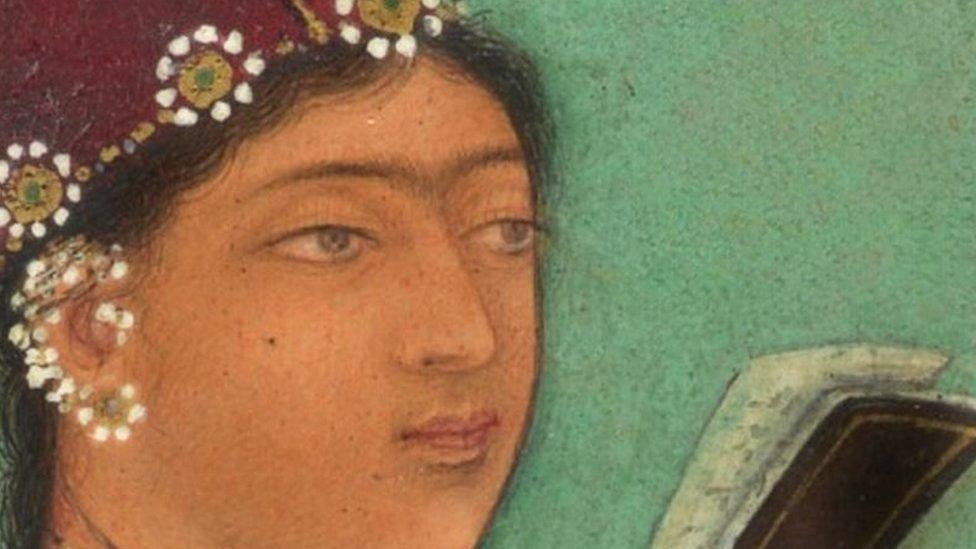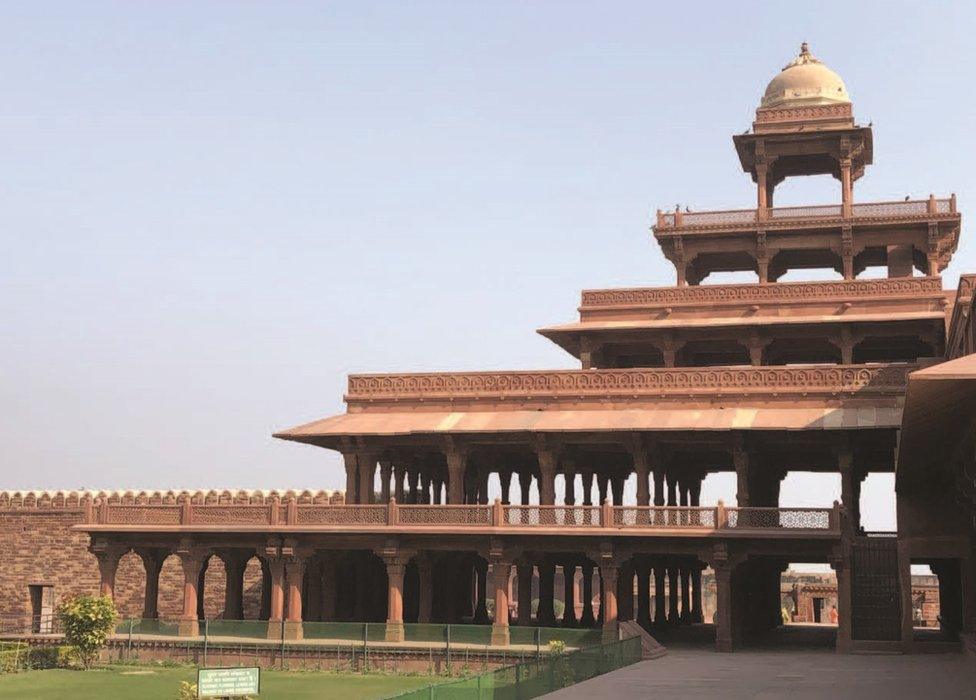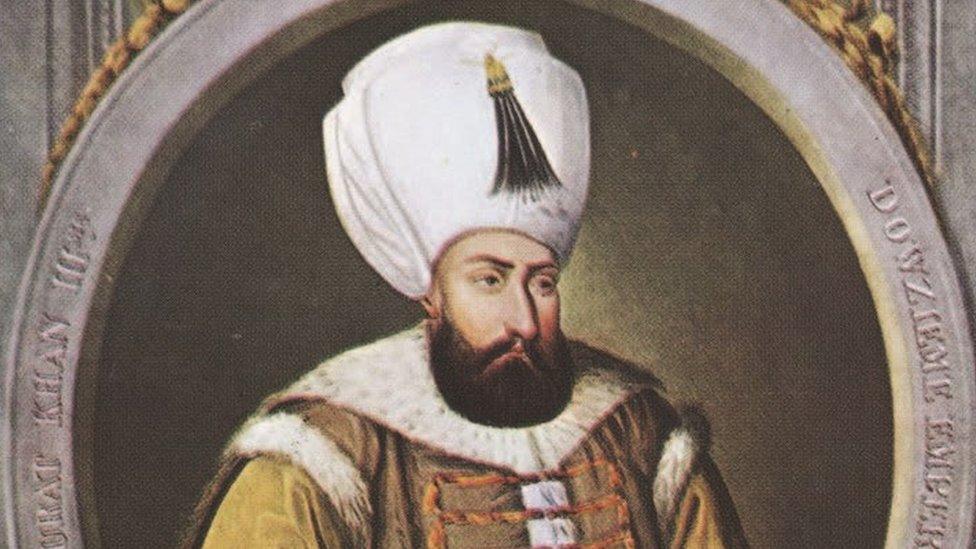Gulbadan Begum: The epic voyage of a daring Mughal princess
- Published

Gulbadan Begum is the first and only woman historian of the Mughal Empire
On an autumn day in 1576, a Mughal princess led a cohort of royal women on an unprecedented voyage to the holy cities of Mecca and Medina.
It was the first time in Mughal India that a woman had gone on the sacred pilgrimage called the Hajj that is considered to be one of the five pillars of Islam.
At the age of 53, Gulbadan Begum - daughter of Babur, founder of the Mughal empire - and 11 women from the royal household - left the confines of a harem in Fatehpur Sikri to set off on a journey that would stretch across six years.
But details of this remarkable journey are missing from the records, possibly due to acts of omission by male court historians eager to preserve the "modesty and sanctity" of the women travellers and their pilgrimage, say historians.
Gulbadan's pilgrimage to Mecca was marked by acts of bravery and kindness, but also rebellion, as author and historian Ruby Lal notes in her book, Vagabond Princess: The Great Adventures of Gulbadan, which recently released in India and is due for an international release later this month.
Even though Gulbadan is regarded as the first and only female historian of the Mughal empire, having chronicled her life experiences in the Humayun-nama, the book curiously lacks details about her journey. In fact, her book is incomplete, with several pages missing.
"Gulbadan was writing at a time when it was common for chroniclers to make copies of works written by royals. But not a single complete copy of Gulbadan's book exists," says Lal, who has pieced together the elusive details of the Mughal princess's trip through her own dedicated research by delving into Ottoman history, Persian and Mughal manuscripts and various other sources.
"The silence around such a powerful woman's one-of-a-kind voyage speaks volumes," says Lal.

Panch Mahal, the pleasure pavilion in the harem headquarters of Fatehpur Sikri
Gulbadan - which roughly translates to rose-hued skin - was born in Kabul in 1523 to Dildar Begum, emperor Babur's third-oldest wife. At the time of her birth, her father was miles away, planning his conquest of Hindustan, as the Indian subcontinent was then known.
The princess would soon get used to seeing her father during the brief visits he made in between the many wars he fought and this separation would mark almost all of her relationships with the powerful men in her family - her father, her half-brother Humayun, and later on, her nephew Akbar.
While the men were away fighting bloody battles for dominance over lands far and wide, Gulbadan grew up in the company of strong women - the emperor's mother, aunts and sisters, his wives and their daughters. They played important roles in courtly affairs, acting as confidantes and advisers to kings and princes.
The little princess's childhood was also marked by movement - at the age of six, she became the first Mughal girl to travel from Kabul to Agra after her father captured the territory. She would make the journey back to Kabul, the land of her childhood, as a married woman after her family was driven out of Hindustan by the Afghan king Sher Shah Suri.
These journeys stretched on for months, and Gulbadan and other royal women would camp in tents, travel in palanquins and on horseback across deserted mountainous terrain, braving enemies, thieves and the elements.
"Mughal women were used to a peripatetic lifestyle," says Lal. "They were constantly migrating to new places or living in temporary camps as they travelled with their men to wars."
This itinerant itch is probably what led the Mughal princess to ask her nephew, Akbar, for permission to go on the Hajj in the late 1500s, says Lal.
Akbar's greatest ambition was to establish the supremacy of the Mughal dynasty and as he made inroads towards this goal in Hindustan, he "began casting himself as a sacred figure, an infallible spiritual authority," Lal writes in the book.
He also became the first Mughal ruler to order the seclusion of all Mughal women in a walled harem.
"The inviolability of the royal harem, penetrable only by the emperor - housing glorious and untouchable women… was meant to be proof of his near divinity," Lal writes.

Sultan Murad III
But this stasis made Gulbadan restless and so in October 1576, she and other royal women set off on the pilgrimage to Mecca, having told Akbar that it was a vow she had made to the divine.
Akbar enlisted the first two grand Mughal ships built by him - Salimi and Ilahi - for their voyage. The royal cohort also carried with them gold-lined chests filled with silver and gold pieces to distribute as alms, cash worth thousands of rupees and 12,000 "dresses of honour".
"Ordinary men and women, old and young, and children lined the streets of the red sandstone Mughal capital, Fatehpur Sikri" to watch the departing cortege, Lal writes in her book.
But the trip was fraught with danger from the outset. The sea route to Mecca was under the control of the Portuguese, who were infamous for burning and plundering Muslim ships. The land route through Persia was equally unsafe - known to harbour militant groups who attacked travellers.
Gulbadan and her companions were stranded at the port of Surat for almost a year before they could secure safe passage from the Portuguese. They sailed for four weeks across the Arabian Sea to reach Jeddah and travelled on camels across hot desert sands for days to reach Mecca.
But the most interesting leg of Gulbadan's journey came after she visited Mecca, as she and her cohort chose to stay back in Arabia for the next four years.
"Unanimous in their decision to leave the harem, they were likewise united in their choice to be vagabonds, mujawirs (spiritual sojourners) in the desert lands," Lal writes in her book.
Here, Gulbadan and her companions doled out alms, coins and other items, becoming the talk of the town. The Mughal princess's benevolence incensed the ruling Ottoman Sultan, Murad, who saw these acts as being a testament to Akbar's political might.
And so the Sultan sent out a series of four decrees to his men, ordering the eviction of Gulbadan and the Mughal ladies from Arabia.
Each time, Gulbadan refused to leave.
"It's an unprecedented act of rebellion by a Mughal woman," says Lal. "It shows how committed Gulbadan was to her desire for freedom."
Finally, the Sultan, aghast at her stubbornness, used the castigatory term in Ottoman Turkish - na-meshru (an inappropriate or erroneous act) against the women, a term considered so severe that it invited the displeasure of Akbar.
It was after this fifth decree that in 1580, Gulbadan and her cohort left Arabia and their convoy reached Khanwa, 60km (37 miles) west of Fatehpur Sikri, in 1582.
On her return, Gulbadan was hailed as a "nawab" (a ruler) and was even invited by Akbar to be the only female contributor in the Akbarnama - a chronicle of the grandeur of Akbar's dynasty commissioned by the emperor himself.
But despite an entire section of the Akbarnama being dedicated to Gulbadan's trip to Mecca, her time in Arabia and censure by Sultan Murad find no mention in the book, or anywhere else.